"A Dallas archaeologist and his field crew have unearthed a treasure more than 2 millennia old gold, silver and bronze artifacts at an Etruscan settlement in Italy. But the scientists are more excited about ruined buildings and walls than they are about the precious metals. The site, called Poggio Colla, is revealing what ordinary life was like for the Etruscans, the builders of Italy's first cities. "
"Poggio Colla spans most of Etruscan history, from roughly 750 B.C. to 150 B.C. The site is unusual because it reveals Etruscan civic life and because it is found so far north."
Subsection of Roman Times:
Articles about current archaeology and research into the remains of Roman and Byzantine civilizations.
Thursday, December 18, 2003
Wednesday, December 17, 2003
Britain and Morocco reach conservation agreement for Volubilius
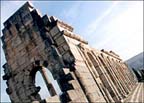 I see that Britain and Morocco have reached a conservation agreement for the ancient Roman site of Volubilius in Morocco.
I see that Britain and Morocco have reached a conservation agreement for the ancient Roman site of Volubilius in Morocco.
“Volubilis was a Roman settlement constructed on what was probably a Carthaginian city, dating from 3rd century BC. Volubilis was a central administrative city responsible for grain production in this fertile region, and exports to Rome. Volubilis was also administering contacts with the Berber tribes which the Romans never managed to suppress, but who only came as far as to cooperate with the Romans for mutual benefits.�
This website has some nice pictures of the site including two of the thirty mosaics uncovered there. The basilica was also very interesting.
Monday, December 15, 2003
Romans: The Original Effects Artists
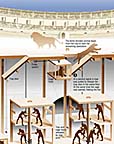 "The Colosseum in Rome was as sophisticated as a modern stage set, according to archaeologists who have calculated how an intricate system of gangplanks, trapdoors and levers was used to bring wild animals into the arena."
"The Colosseum in Rome was as sophisticated as a modern stage set, according to archaeologists who have calculated how an intricate system of gangplanks, trapdoors and levers was used to bring wild animals into the arena."
"We found the Romans invested an enormous amount of energy in making their games ever more spectacular," said Heinz-Juergen Beste. "We had to do a lot of research to recreate this stage. What we found was an extremely sophisticated system."
By measuring the floor space and cavities in the walls where wooden lifts, levers and cages would have been constructed, and comparing their findings with contemporary accounts of how animals "magically appeared", the archaeologists have pieced together how the mechanisms worked.
"We can tell that two or three different mechanical systems were installed. We have found more than 28 lifts used to get animals into the Colosseum. With a pull of a lever they could send scenery, artificial forests or castles made of papier-mache into the arena. The animals were taken down into the basement where they were put into cages.
"From there they were hauled up to a second level, and the door to the cages opened. The beasts would then run up ramps and out into the arena."
Thursday, December 11, 2003
Fragments of Roman Wine Amphora Found in Site of Ancient Indian Port
"Southampton varsity scholar Roberta Tomber claims that the pottery pieces found by K P Shajan, a marine geologist, from Pattanam near Paravoor, are parts of Roman wine amphora, Mesopotamian torpedo jar and Yemenite storage jar. 'It is the first time that we have found evidence in Malabar coast. The clay is very different from what was used in India during the same period. A lot of black minerals are present,' she says. "
If this claim is true, then the pieces are the first evidence of Roman pottery to be found in Kerala. It also strengthens the theory that the port of Muziris was in the belt of Kodungallur-Chettuva.
"These were found in Pattanam, north of Paravoor. The whole area is strewn with pottery samples. Though many of them are of Indian origin, a few pieces of Indo-Roman era were also found. A detail exploration of the area will alone help establish this fact," Shajan, who chanced upon the evidence during a geological survey, said.
If this claim is true, then the pieces are the first evidence of Roman pottery to be found in Kerala. It also strengthens the theory that the port of Muziris was in the belt of Kodungallur-Chettuva.
"These were found in Pattanam, north of Paravoor. The whole area is strewn with pottery samples. Though many of them are of Indian origin, a few pieces of Indo-Roman era were also found. A detail exploration of the area will alone help establish this fact," Shajan, who chanced upon the evidence during a geological survey, said.
Tuesday, December 09, 2003
Ancient Bronze Age Chariot Points to Early European Trade
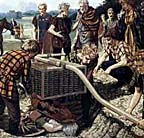 Archaeologists have discovered a “rare and nationally significant� Iron Age chariot buried for 2,500 years near West Yorkshire. The find is a complete chariot containing the skeleton of a tribal leader, with the remains of at least 250 cattle, probably slaughtered for the funeral feast. Chariot burial at the time – between 500BC and 400BC – was reserved for high-ranking figures from a tribe a tribe known as the Arras, who came to England from France.
Archaeologists have discovered a “rare and nationally significant� Iron Age chariot buried for 2,500 years near West Yorkshire. The find is a complete chariot containing the skeleton of a tribal leader, with the remains of at least 250 cattle, probably slaughtered for the funeral feast. Chariot burial at the time – between 500BC and 400BC – was reserved for high-ranking figures from a tribe a tribe known as the Arras, who came to England from France.
Oxford archaeologists said: “Insights gained from this latest discovery will make a significant addition to our understanding of the burial rites of the period, and help us to understand a wide range of other elements of cultural exchange, including aspects of social reproduction and cross-Channel contact and communication.�
Ghost fleet found at Pisa to be housed in new museum
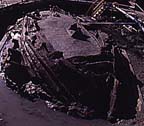 "The chance discovery of a Roman 'ghost fleet' buried in mud just outside Pisa has led experts to conclude that the city was built on a lagoon much like an early Venice. Archaeologists believe that traces of a community dating back to a pre-Roman era, a sort of 'Etruscan Venice', may lie beneath the ships."
"The chance discovery of a Roman 'ghost fleet' buried in mud just outside Pisa has led experts to conclude that the city was built on a lagoon much like an early Venice. Archaeologists believe that traces of a community dating back to a pre-Roman era, a sort of 'Etruscan Venice', may lie beneath the ships."
"The find first came to light five years ago when a bulldozer involved in work to build railway offices beside the San Rossore station on the outskirts of Pisa came across an ancient wooden ship 30ft below ground. A large archaeological dig which was started under Prof Bruni's direction later found four ships dating from various Roman periods. The number of vessels, which were found in remarkable condition, rose to six, then nine, and finally 21, including what experts believe may be a Roman warship. They date from 200BC-AD500."
"The ships will soon be housed in a new museum in Pisa's old shipyards, Giuliano Urbani, Italy's culture minister, announced last week. "It will not just be a building," he said. "It will also be a kind of historical space which will develop in tandem with the stages of recovery and restoration of the ships."
Friday, December 05, 2003
Lost Worlds: When the Romans Ruled Africa
Australians will be able to watch a new French documentary about excavations now underway in Tunisia. Hopefully, it will find its way to the BBC and the Discovery or History Channels for those of us in the US.
"French and Tunisian archaeologists are excavating a Roman-era necropolis in modern-day Hammamet, in north Africa. For five centuries, Tunisia was part of the Roman empire. Those buried or burnt here were mostly ordinary people.
Perhaps they worked on the many Roman buildings that dot the countryside. Their tombs are humble: babies buried in amphorae, a woman burnt with a mirror and necklace, and, everywhere, oil lamps and pottery dishes left from the families' last meal with the dead.
Were they Africans who had become Romanised, or vice-versa?"
"French and Tunisian archaeologists are excavating a Roman-era necropolis in modern-day Hammamet, in north Africa. For five centuries, Tunisia was part of the Roman empire. Those buried or burnt here were mostly ordinary people.
Perhaps they worked on the many Roman buildings that dot the countryside. Their tombs are humble: babies buried in amphorae, a woman burnt with a mirror and necklace, and, everywhere, oil lamps and pottery dishes left from the families' last meal with the dead.
Were they Africans who had become Romanised, or vice-versa?"
ABC to tackle "Empire" series
"ABC has greenlit production on the eight-hour project Empire, an epic take on the fate of the Roman Empire."
"The project, which had been developed under the working title 'Tyrannus,' follows the story of Julius Caesar's nephew Octavius, who battles general Marc Antony for control of Rome after Caesar is assassinated. Octavius finds an ally in Tyrannus - the gladiator assigned to protect him - and eventually becomes the emperor Augustus."
"The project, which had been developed under the working title 'Tyrannus,' follows the story of Julius Caesar's nephew Octavius, who battles general Marc Antony for control of Rome after Caesar is assassinated. Octavius finds an ally in Tyrannus - the gladiator assigned to protect him - and eventually becomes the emperor Augustus."
Thursday, December 04, 2003
Michael Apted to direct "Rome"
"Michael Apted ('The World Is Not Enough,' 'Coal Miner's Daughter') has signed on to direct the first three episodes of 'Rome,' an HBO series set in the time of Caesar and the rise of the Roman Empire. The series, a co-production of HBO and the BBC, is scheduled for a 2005 premiere.
The series, which is set to begin filming in March, will chronicle the lives of two Roman soldiers and their families. HBO calls it 'an intimate drama' set against the epic backdrop of the Rome circa 51 BC."
The series, which is set to begin filming in March, will chronicle the lives of two Roman soldiers and their families. HBO calls it 'an intimate drama' set against the epic backdrop of the Rome circa 51 BC."
Tuesday, December 02, 2003
Roman Baths in the City of Bath
A nice comprehensive site on the Roman Baths of Bath and the current development of a modern bathing complex.
Wednesday, November 26, 2003
Walnuts, An Ancient Symbol of Both Fertility and Infertility
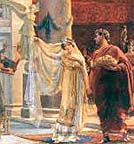 "In the days when it was common for poor folk to eat acorns (glans in Latin), walnuts were called Jovis glans, the nuts of Jove (Jupiter), king of the gods. Later, they came to be known as Juglans regia, or royal nut, and that remains its botanical name. In Roman times they were also known as Persian nuts for they may have been introduced to the empire by way of Persia. "
"In the days when it was common for poor folk to eat acorns (glans in Latin), walnuts were called Jovis glans, the nuts of Jove (Jupiter), king of the gods. Later, they came to be known as Juglans regia, or royal nut, and that remains its botanical name. In Roman times they were also known as Persian nuts for they may have been introduced to the empire by way of Persia. "
"In classical times, when it was believed that the shape of a particular food denoted its usefulness, walnuts were considered fodder for the brain. The green husk was likened to the human scalp; the hard nut shell to the skull; the papery partitions to the membrane; and the nutmeat to the two hemispheres of the brain, explained Waverly Root in "Food" (Konecky & Konecky, 1980). "
"According to Roman lore, the gods feasted on walnuts while their lowly subjects subsisted on lesser nuts such as acorns, beechnuts, and chestnuts. Walnuts were thrown to Roman wedding guests by the groom to bring good health, to ward off disease and increase fertility. Young boys eagerly scrambled for the tossed walnuts, as the groom's gesture indicated his passage into manhood. In Rome, the walnut was thought to enhance fertility, yet in Romania, a bride would place one roasted walnut in her bodice for every year she wished to remain childless. "
"Early cultivation spanned from southeastern Europe to Asia Minor to the Himalayas. Greek usage of walnut oil dates back to the fourth century B.C., nearly a century before the Romans."
"To the ancient Greeks, walnuts were karyon basilikon or persikon -- royal or Persian walnut, noted Alan Davidson in "The Oxford Companion to Food" (Oxford University Press, 1999). But he leaves out a delightful tale related in "The Walnut Cookbook": In Greek mythology, Dionysus, the god of wine, fell in love with a maiden named Carya. When she died suddenly, he transformed her into a walnut tree. (There's that wine and walnuts connection again.) "The goddess Artemis carried the news to Carya's father and commanded that a temple be built in her memory. Its columns, sculpted in wood in the form of young women, were called caryatides, or nymphs of the walnut tree -- so the tree furnished the image for a famous Greek architectural form," wrote Toussaint."
See also: Walnuts
Monday, November 17, 2003
Iceni Torq unearted in Norfolk
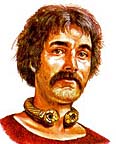 "An Iron Age torc has been unearthed in a Norfolk field. Norfolk Museums Service expert Dr John Davies said the item dated back to the Iceni tribe, probably a generation before Iceni leader Boudicca lived.
"An Iron Age torc has been unearthed in a Norfolk field. Norfolk Museums Service expert Dr John Davies said the item dated back to the Iceni tribe, probably a generation before Iceni leader Boudicca lived.
A report by Dr JD Hill of the British Museum revealed that the item, which was made between 200 and 50 BC , survived more than 2000 years intact before suffering recent minor damage from agricultural machinery.
Dr Davies said the electrum torc would have belonged to a prestigious figure in Iron Age Norfolk and Boudicca would have worn similar jewellery."
Wednesday, November 12, 2003
Etruscan Art Featuring Demons Indicate Shift in Religious Beliefs
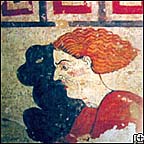 "Etruscan art, made of strange demons and monsters, is emerging in a Tuscan village, in what could be one of the most important discoveries of recent times, according to scholars who have seen the paintings."
"Etruscan art, made of strange demons and monsters, is emerging in a Tuscan village, in what could be one of the most important discoveries of recent times, according to scholars who have seen the paintings."
"Lurking on the left wall of a 4th century B.C. tomb, the exceptionally preserved monsters have been unearthed during the ongoing excavation of the Pianacce necropolis in Sarteano, a village 50 miles from Siena, Italy."
Vividly colored, the scenes in the tomb reflect a sinister change in the Etruscan concept of death. A fun loving and sensuous people, on the verge of decline they adopted the Greek vision of a demon-infested underworld.
"The figure with red hair is surely a death demon of some kind. This is confirmed by the black figure at her side, used by the Etruscans to characterize demons," chief archaeologist Mario Iozzo, director of the Center for Conservation in Florence and Chiusi's Archaeological Museum, told Discovery News.
Wednesday, November 05, 2003
Researcher says aqueduct mineral deposits indicate Rome fell 500 years later than believed
Bruce Fouke, a University of Illinois professor studying the interaction of microbes and minerals speculates that the deposits in Roman aqueducts indicate the Empire fell about 500 years later than generally believed.
" When Rome thrived, the Romans gave the aqueduct system a regular cleaning. After the empire began the slip, the maintenance lapsed, and mineral deposits, deposits not unlike those at Yellowstone, built up. Think of the ring that develops in your bathtub if you get lax about scrubbing it."
Fouke, Hostetter and UI geology Professor Craig Lundstrom have been working on dating those deposits, using Lundstrom's expertise in tracing the decay of uranium into thorium, to find out when the water stopped flowing.
"We might be able to start saying some pretty interesting things about the collapse of Rome," Hostetter said.
They might be able to say Rome's collapse, as reflected in the state of its aqueducts, actually happened about 500 years later than believed, a significant revision of the historical record.
" When Rome thrived, the Romans gave the aqueduct system a regular cleaning. After the empire began the slip, the maintenance lapsed, and mineral deposits, deposits not unlike those at Yellowstone, built up. Think of the ring that develops in your bathtub if you get lax about scrubbing it."
Fouke, Hostetter and UI geology Professor Craig Lundstrom have been working on dating those deposits, using Lundstrom's expertise in tracing the decay of uranium into thorium, to find out when the water stopped flowing.
"We might be able to start saying some pretty interesting things about the collapse of Rome," Hostetter said.
They might be able to say Rome's collapse, as reflected in the state of its aqueducts, actually happened about 500 years later than believed, a significant revision of the historical record.
Friday, October 31, 2003
The Roman Empires Rises Again In Sand
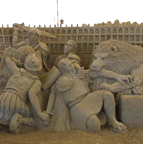 "I stumbled across this website and was amazed at the beauty of these sand sculptures depicting images of the Roman Empire. The city of Jesolo, Italy sponsors this sand sculpture competition each year with a different theme. I heartily approve of this year’s subject!
"I stumbled across this website and was amazed at the beauty of these sand sculptures depicting images of the Roman Empire. The city of Jesolo, Italy sponsors this sand sculpture competition each year with a different theme. I heartily approve of this year’s subject!
Rome's sea route reopens after 200 years
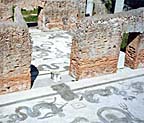 "Riverboats will return to ancient Rome's sea route for the first time in 200 years next week, giving tourists a view from the Tiber river to rival any of the Eternal City's attractions on dry land. The boats will ply a disused route along the green-tinged river from the edge of the city centre to the mosaic-filled ruins of Ostia Antica -- a two-hour trip away from the whizz of scooters and the pilgrims at St Peter's Square in the Vatican."
"Riverboats will return to ancient Rome's sea route for the first time in 200 years next week, giving tourists a view from the Tiber river to rival any of the Eternal City's attractions on dry land. The boats will ply a disused route along the green-tinged river from the edge of the city centre to the mosaic-filled ruins of Ostia Antica -- a two-hour trip away from the whizz of scooters and the pilgrims at St Peter's Square in the Vatican."
"It was the greatest gateway to Rome," said Anna Gallina Zevi, chief archaeologist of the sixth century ruins during the inaugural sail late on Saturday.
"Wines, olives, marble for St Peter's, salt from the coast, ceramics from all over the Mediterranean... plundered obelisks from Africa, elephants for the games at the Colosseum all came up the river."
Thursday, October 30, 2003
Successful Roman Festival Sparks Call For Community Dig
MIDDLEWICH Roman Festival has proved to be such a success that the town has developed a vision for a museum and a 'community dig' to retrieve archeological items. Town clerk Jonathan Williams has teamed up with archeologist Tim Strickland to bid for a grant of almost £50,000 from the Heritage Lottery Fund. They are hoping that a grant would enable them to carry out further research on Roman Middlewich and look at the potential for a museum.
"The grant money could also help to fund a community dig", said Williams, "as this would be a great way to get people involved in searching for Roman artefacts that could eventually be displayed for the whole town to see."
"The grant money could also help to fund a community dig", said Williams, "as this would be a great way to get people involved in searching for Roman artefacts that could eventually be displayed for the whole town to see."
Monday, October 27, 2003
Earliest Private Chapel in Roman Villa Unearthed
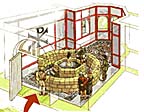 "The earliest private chapel from Dark Age Britain has been unearthed in the foundations of a Roman 'stately home'.
"The earliest private chapel from Dark Age Britain has been unearthed in the foundations of a Roman 'stately home'.
The fifth century font and baptistry were built into the ornate mosaic floor of an unusual double villa in Wiltshire not long after the Romans left Britain.
Although there are older chapels, archaeologists say it is the earliest example of a landowner converting rooms inside his home for baptisms."
Verulamium Saved From The Plough
 "Verulamium, a site treasured by archaeologists for years as a unique monument to Roman Britain, is now safe from destruction by the plough, thanks to an important agreement between English Heritage and the local landowner. The agreement, announced on October 22, will ensure that fields covering part of one of the country’s most important archaeological sites, near St.Albans, are taken permanently out of cultivation and converted to permanent pasture. Ancient hedgerows that had been removed to facilitate cultivation will be re-instated. "
"Verulamium, a site treasured by archaeologists for years as a unique monument to Roman Britain, is now safe from destruction by the plough, thanks to an important agreement between English Heritage and the local landowner. The agreement, announced on October 22, will ensure that fields covering part of one of the country’s most important archaeological sites, near St.Albans, are taken permanently out of cultivation and converted to permanent pasture. Ancient hedgerows that had been removed to facilitate cultivation will be re-instated. "
Founded about AD 49, a few years after the Claudian invasion of Britain, Verulamium has been key to our understanding of Roman civilisation and urban development in the Empire. Eventually covering about 200 acres, the town had a full range of public buildings, including a temple, forum, theatre and amphitheatre. More than 30 mosaics have been found.
Wednesday, October 22, 2003
Large 1st Century Roman Bath House Found In Nazareth
"Professor Richard Freund, of the Maurice Greenberg Centre for Judaic Studies at Hartford University in Connecticut, says the discovery means that historians will have to rethink the place and significance of Nazareth in the Roman empire and consequently the formative experiences of Jesus. It has been assumed that the Nazareth of 2,000 years ago was a poor Jewish village on the periphery of the empire, where local families inhabited caves on the hillside that today contains the modern Israeli-Arab city. On this view, the young Jesus would have had little contact with the Romans until he left Nazareth as an adult; his father, Joseph, one of many craftsmen in the town, may have worked on a Roman palace at nearby Sephori.
But the huge scale of Shama's bathhouse suggests that Nazareth, rather than Sephori, was the local hub of military control from Rome. The giant bath could only have been built for a Roman city or to service a significant garrison town. That would mean Joseph and Mary, and their son Jesus, would have been living in the very heart of the occupying power. This is likely to have huge significance for New Testament scholars in their understanding of Jesus's later teachings. "
But the huge scale of Shama's bathhouse suggests that Nazareth, rather than Sephori, was the local hub of military control from Rome. The giant bath could only have been built for a Roman city or to service a significant garrison town. That would mean Joseph and Mary, and their son Jesus, would have been living in the very heart of the occupying power. This is likely to have huge significance for New Testament scholars in their understanding of Jesus's later teachings. "
Row-powered Roman Cargo Barges Discovered
 "Dutch archaeologists have discovered a Roman cargo ship equipped with oars, a unique find that explains how imperial Rome defended itself on its northern frontiers.
"Dutch archaeologists have discovered a Roman cargo ship equipped with oars, a unique find that explains how imperial Rome defended itself on its northern frontiers.
The barge, dating from around 100AD, was excavated in the Dutch town of Woerden, which was once the location of the Roman military settlement Castellum Laurium on the banks of the Rhine.
The flat-bottomed boat was manned by at least 12 rowers. The oars would have allowed the Romans to navigate strong currents back to the German Eiffel region from where it had brought rocks to strengthen the forts along the frontier. "
Dogs In The Roman Empire
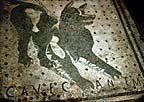 "The Roman empire became a melting pot of dogs from all its conquests. As in ancient Egypt, Roman dogs served in a variety of roles, from companions and guard dogs to vicious fighting dogs pitted against slaves and wild animals.
"The Roman empire became a melting pot of dogs from all its conquests. As in ancient Egypt, Roman dogs served in a variety of roles, from companions and guard dogs to vicious fighting dogs pitted against slaves and wild animals.
The proverbial “dogs of war” were also Roman. Huge and fearsome Molossians, which resembled giant Rottweilers, were sent into battle to kill and dismember the enemy.
Mollosian, now extinct, originally came from Greece, where they were also used for fighting. Alexander the Great owned a Mollosian named Peritas who, legend has it, killed a lion and an elephant in fighting matches.
Roman citizens sometimes had Mollosian guard dogs. In Pompeii, archaeologists have found mosaics depicting Mollosians outside people’s homes with the message cave canem – “beware of the dog”."
Tuesday, October 21, 2003
Legions in German Frontier Entertained in Theater
"Archaeologists have discovered the remains of a Roman theatre in the small German town of Kuenzing, suggesting that soldiers at the front were entertained by gladiators and animal fights.
Known as Quintanis in Roman times, the town was on the Danube frontier of the Roman empire and garrisoned by 500 mercenaries."
Known as Quintanis in Roman times, the town was on the Danube frontier of the Roman empire and garrisoned by 500 mercenaries."
Tuesday, October 14, 2003
Tombs Reveal Ancient Culture in Po Valley
 Dating between 1500 and 1200 B.C., a necropolis consisting of more than 2,000 tombs belonging to the people of the "terramare" — prehistoric flat-topped mounds left by a Bronze Age pile-dwelling settlement built on dry land, are being excavated near Modena, Italy.
Dating between 1500 and 1200 B.C., a necropolis consisting of more than 2,000 tombs belonging to the people of the "terramare" — prehistoric flat-topped mounds left by a Bronze Age pile-dwelling settlement built on dry land, are being excavated near Modena, Italy.
"It is interesting that the tombs did not contain arms [weapons] but only female objects, mainly bronze items such as brooches and pendants. We found arms gathered in another area of the cemetery. They had been burned and broken, probably in a funerary ritual," project director Andrea Cardarelli, professor of prehistory and proto-history at Modena University said.
Despite the precariously preserved cremated bones, Cardarelli has begun an anthropological study which in the following months should reveal not only the sex and age of the buried people but — thanks to specific chemical signals (isotopic values) in bones — their diet.
Remains Of Woman Warrior Found
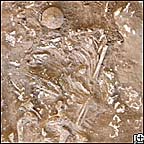 "Remains Of Xena-Like Woman Found: "The remains of a six-foot tall woman, buried with a shield and knife, were recently discovered in an Anglo-Saxon cemetery in Lincolnshire, England.
"Remains Of Xena-Like Woman Found: "The remains of a six-foot tall woman, buried with a shield and knife, were recently discovered in an Anglo-Saxon cemetery in Lincolnshire, England.
The body and artifacts, which date to A.D. 500-600, suggest that more women than previously believed may have fought alongside men during the turbulent years following England's Roman period. "
"...the shield had been placed on top of the woman before burial. The knife rested alongside her unusually tall body. Even most men at the time measured several inches shorter.
"Another unusual aspect of the burial was that the feminine jewelry and clothing accessories normally found in women's graves from this period were not present. Instead, her feet were bound with rope, and the only adornment was an amber necklace draped around her neck."
"In addition to the shields, remains of two other individuals — a man and another woman — were unearthed. None of the individuals appears to have been related or otherwise connected to one another. The second woman was of average height and wore the wrist clasps, girdle hangers, and little pieces of bronze jewelry more commonly found in female graves of the time."
Roman baths threatened by water
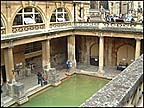 "Emergency work is under way in Somerset after water leaks at Roman baths were found to be destroying an artefact more than 1,700 years old. Stephen Clews, curator of the Roman baths, said: "It may seem odd that water should be a problem for a bath.
"Emergency work is under way in Somerset after water leaks at Roman baths were found to be destroying an artefact more than 1,700 years old. Stephen Clews, curator of the Roman baths, said: "It may seem odd that water should be a problem for a bath.
"But what is happening is a cycle of wetting and drying has developed as the condition of the road above deteriorates and leaks form.
"Over time salt in the water causes problems with the structure of the ancient stonework and Roman renders," he added.
Friday, October 10, 2003
Enameled Roman vessel found in Staffordshire Hills
 Although this item was posted in January, it only now came to my attention and I admired the artistry of the piece.
Although this item was posted in January, it only now came to my attention and I admired the artistry of the piece.
An exquisite bronze pan found in the Staffordshire Hills has drawn the attention of experts because it is decorated with Celtic motifs and features an engraved inscription just below the rim.
"It lists the four forts at the western end of Hadrian's Wall in sequence: Mais (Bowness), Coggabata (Drumburgh), Uxelodunum (Stanwix), and Cammoglanna (Castlesteads).
It also carries a Greek name - 'Aelius Draco'. "
"Sally Worrell, of the Portable Antiquities Scheme, said: "Aelius Draco was perhaps a veteran of a garrison of Hadrian's Wall and, on retirement, had this pan made to recall his time in the army. His name suggests that he or his family originated in the Greek-speaking part of the eastern Roman Empire."
The pan was probably used like a saucepan.
Monday, October 06, 2003
Layers Of Pompeii Dating Back to 3rd Century BC Unearthed
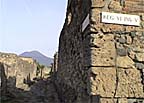 ""After three years of research, the Pompeii that Mount Vesuvius did not bury is coming to light, according to Italian archaeologists.
""After three years of research, the Pompeii that Mount Vesuvius did not bury is coming to light, according to Italian archaeologists.
Hidden in layers beneath the town overwhelmed by lava and ash by the most famous eruption in history, the ancient settlement dates back to the third century B.C. "
"With his colleague Filippo Coarelli of Perugia University, Pesando investigated a series of houses in the Regio VI quarter in the northern area of the town, which carried several of those unusual architectural features. "
The town that is coming to light is slightly different. It was characterized by steps and narrow streets accessible only with donkeys, while row of smaller houses lined larger streets."
"Pompeii was built on steps degrading toward [the] south. This is one of the reasons why the site was originally chosen to build a settlement. Given the town's position, rain water would have flowed down preventing floods," Pesando said."
"In the following century, Pompeii slowly turned into the city that visitors admire today. The steps disappeared and new houses were built on top of the old ones, making the town more even and regular. "
Roman building found on site of new RAF baseball field
Archaeologists digging where the RAF base Mildenhall plans to build a new baseball field have found cattle and human bones from the Iron Age, and coins, brooches and human bones from the Roman era.
The dig has unearthed a Roman building more than 30 feet wide and a body from the late Iron Age or early Roman era buried on its face. A couple bodies have yet to be excavated. One is in a wooden casket, meaning it is certainly Roman.
The dig has unearthed a Roman building more than 30 feet wide and a body from the late Iron Age or early Roman era buried on its face. A couple bodies have yet to be excavated. One is in a wooden casket, meaning it is certainly Roman.
Wednesday, October 01, 2003
Ancient Roman church discovered in Turkey
"A church from the era of the ancient Roman Empire (late period) was discovered in the district of Golhisar, in the city of Burdur when a villager from Yusufca stumbled across painted frescos. The director of Burdur Museum Haci Ali Ekinci announced that restoration of this ancient church will begin next year."
New Method Developed For Dating Archaeological Pottery
Researchers at Britain's University of Bristol have developed the first direct method for dating pottery by examining animal fats preserved inside the ceramic walls.
Pottery is essential for classifying archaeological sites. Organic materials, such as wood and bone, can easily be dated using radiocarbon techniques, but they aren't always available or reliable. Wood tends to decompose over time, and animals often dig up bones and move them around a site. Ceramics, however, have a long and stable lifespan.
"If you go to a site and you find large amounts of Roman pottery, then you know you've got a Roman site," says Richard Evershed, Ph.D., a chemist at the University of Bristol and lead author of the paper. "Later pottery, such as Roman, is relatively easy to date from its appearance, but earlier pottery can be much harder because of its rough and ready appearance. That's where the appeal of having a technique like this comes in."
Pottery is essential for classifying archaeological sites. Organic materials, such as wood and bone, can easily be dated using radiocarbon techniques, but they aren't always available or reliable. Wood tends to decompose over time, and animals often dig up bones and move them around a site. Ceramics, however, have a long and stable lifespan.
"If you go to a site and you find large amounts of Roman pottery, then you know you've got a Roman site," says Richard Evershed, Ph.D., a chemist at the University of Bristol and lead author of the paper. "Later pottery, such as Roman, is relatively easy to date from its appearance, but earlier pottery can be much harder because of its rough and ready appearance. That's where the appeal of having a technique like this comes in."
Monday, September 29, 2003
Roman-era Olive Press Found on Malta
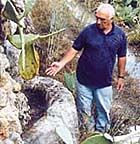 "What could be part of an olive press dating back to Roman times has been discovered embedded under a high rubble wall on the outskirts of Nadur.
"What could be part of an olive press dating back to Roman times has been discovered embedded under a high rubble wall on the outskirts of Nadur.
The press was discovered by Lino Bugeja, of Marsascala, while walking down the winding road to Ramla bay last week.
Mr Bugeja said he was convinced the large round stone was a press because it was practically identical in shape and size to the existing olive press at the Archaeology Museum in Gozo. The one in the museum was one of two found in Xewkija."
Horsehoes evolved from Roman hipposandals
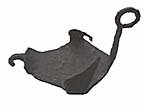 While I was skimming abstracts of different news items this week, I noticed
While I was skimming abstracts of different news items this week, I noticed
a statement that Romans invented the game of horseshoes. It got me to
wondering about when horseshoes were developed. I found this interesting
reference to the first horseshoes called "hipposandals" by the Romans that
were tied on.
"Sometime after the first century, horses with shod hooves traversed the
roadways set down by ancient Romans. To protect their valuable steeds,
riders outfitted their horses with coverings inspired by the sandals
strapped to their own feet. These leather and metal "hipposandals" fitted
over horses' hooves and fastened with leather straps."
"In the colder, damper climates of northern Europe, however, horses were
used in farming and had trouble gaining a toehold on the surface. Horsemen
tried various remedies, and by the 6th & 7th centuries began nailing metal
shoes onto their horses' hooves."
Armed with the term "hipposandal", I continued my research and found this
picture of an early "hipposandal".
I guess it should not be a surprise that the Romans developed such
protection for the feet of their horses since their animals were used
extensively on all of those paved Roman roads!
Third Largest Collection of Gladiator Inscriptions Found in Cordoba
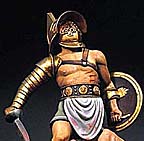 The largest collection of gladiator inscriptions known outside Rome have been discovered in an amphitheater in Cordoba. An archaeology professor at the University of Cordoba, Desiderio Vaquerizo said the amphitheater could hold up to 50,000 people. It is the third largest after the Colloseum in Rome and the amphitheater in the ancient Tunisian city of Carthage.
The largest collection of gladiator inscriptions known outside Rome have been discovered in an amphitheater in Cordoba. An archaeology professor at the University of Cordoba, Desiderio Vaquerizo said the amphitheater could hold up to 50,000 people. It is the third largest after the Colloseum in Rome and the amphitheater in the ancient Tunisian city of Carthage.
Monday, September 22, 2003
Roman weapons factory unearthed
"Archaeologists excavating the site of a huge iron factory on Exmoor believe it might have been used to help produce weapons for the Roman army. Hundreds of tons of iron was produced on the site between 100AD and 300AD - far more than was needed locally. It is thought a lot of the iron produced there 2,000 years ago was destined for national and even international markets to make weapons and tools. The factory is on such a massive scale they are wondering whether the Romans may have had a greater influence in the South West than previously believed.
2nd Century Gold Tablet Found in Norfolk
A gold Roman tablet engraved with magic symbols which is about an inch square and thought to date back to the second century AD has been found by a man working in his garden in Dereham, Norfolk.
Thursday, September 18, 2003
Roman Coins Unearthed at Al Jouf
 Al-Jouf, first mentioned in recorded history in the royal Annals of Assyria, when it was attacked by the Assyrian King Sennacherib in 688 BC, is the site of a discovery of Roman coins. The coins were unearthed on a hillside a few kilometers behind the Aramco oil terminal outside Sakaka. The regional capital of the northern province of Al-Jouf, Sakaka contains Saudi Arabia’s equivalent of Stonehenge. The cluster of sandstone stele, known as Al-Rajajil, have stood here for more than 6,000 years. Standing astride the trade routes from Syria and Iraq to Yemen, Syrian, Roman and Greek artifacts have all been found here.
Al-Jouf, first mentioned in recorded history in the royal Annals of Assyria, when it was attacked by the Assyrian King Sennacherib in 688 BC, is the site of a discovery of Roman coins. The coins were unearthed on a hillside a few kilometers behind the Aramco oil terminal outside Sakaka. The regional capital of the northern province of Al-Jouf, Sakaka contains Saudi Arabia’s equivalent of Stonehenge. The cluster of sandstone stele, known as Al-Rajajil, have stood here for more than 6,000 years. Standing astride the trade routes from Syria and Iraq to Yemen, Syrian, Roman and Greek artifacts have all been found here.
Tuesday, September 16, 2003
Could Gold Be Gift From Caesar
 "They thought it had been made by skilled local craftsman in the last century before the Roman invasion. But scientific analysis of an Iron Age gold hoard found near Winchester in 2000 showed it was made by Roman or Hellenic craftsman between 70BC and 30BC," said Dr. Dick Whinney, curator of the British Museum.
"They thought it had been made by skilled local craftsman in the last century before the Roman invasion. But scientific analysis of an Iron Age gold hoard found near Winchester in 2000 showed it was made by Roman or Hellenic craftsman between 70BC and 30BC," said Dr. Dick Whinney, curator of the British Museum.
Dr Whinney observes: "We're never going to prove the gold was a gift from Caesar or Antony. But if we take the technological evidence about the origin and craftsmanship of these items alongside the time frame, it is a good theory. "The implication is they were made to order in a style that would be acceptable to native kings and queens, possibly to cement a friendship or encourage an alliance."
When the legions invaded, they were unopposed by local tribes, although they had the manpower and fortifications to fight. "There were no battles here. The Romans were allowed to pass through what appears to have been a client kingdom."
See also: The Winchester Hoard
Wednesday, September 10, 2003
Portraits from Fayum
 I have always loved the Greco-Roman mummy portraits from the Fayum region of Egypt and today stumbled across this wonderful site about them. Discovered in March, 1888 by Flinders Petrie, the site was termed 'an immense cemetery of Roman time with rooms brick-built tombales still containing the bodies of their owners'. He became quite emotional when he gazed on the first portrait still fixed to its mummy, 'a splendidly drawn girl, with sweet grey tints'. "
I have always loved the Greco-Roman mummy portraits from the Fayum region of Egypt and today stumbled across this wonderful site about them. Discovered in March, 1888 by Flinders Petrie, the site was termed 'an immense cemetery of Roman time with rooms brick-built tombales still containing the bodies of their owners'. He became quite emotional when he gazed on the first portrait still fixed to its mummy, 'a splendidly drawn girl, with sweet grey tints'. "
I found this portrait particularly poignant.
Wednesday, September 03, 2003
Ancient pirate stronghold unearthed at Antikythera
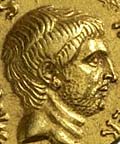 Archaeologists digging at the ancient city of Antikythera have located sanctuaries, a large public building and a wealth of missiles — spear and arrow heads, slingshots and large catapult stones — in the settlement identified as the city of Aegila mentioned in ancient sources. Antikythera controlled the strait between Kythera and western Crete, a crucial passage for shipping.
Archaeologists digging at the ancient city of Antikythera have located sanctuaries, a large public building and a wealth of missiles — spear and arrow heads, slingshots and large catapult stones — in the settlement identified as the city of Aegila mentioned in ancient sources. Antikythera controlled the strait between Kythera and western Crete, a crucial passage for shipping.
The site, occupied from the mid-fourth to the mid-first centuries BC, may have been a nest of pirates, at a time when piracy was quasi-legitimate. Archaeologists also located a large boat shed “which protected the constantly war-ready pirate ships.”
I wonder if this port could have served as a base for Sextus Pompeius?
Senua, Britain's unknown goddess unearthed
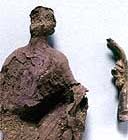 "Senua, a previously unknown Romano-British goddess, has been resurrected at the British Museum, patiently pried from soil-encrusted clumps of gold and corroded silver which have buried her identity for more than 1,600 years."
"Senua, a previously unknown Romano-British goddess, has been resurrected at the British Museum, patiently pried from soil-encrusted clumps of gold and corroded silver which have buried her identity for more than 1,600 years."
Ralph Jackson, Roman curator at the British Museum, said he believes Senua was probably an older Celtic goddess, worshipped at a spring on the site, who was then adopted and Romanised - twinned with their goddess Minerva - by the invaders. There is a direct parallel at Bath, where the Romans seamlessly absorbed the Celtic god Sulis, and a much older shrine, into their religion.
New Mosaics And Frescos Excavated At Zeugma
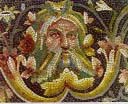 "New mosaics and frescos have been excavated from the ancient city of Zeugma located in Belkis Village 10 km east from Nizip town of southeastern Gaziantep province, by the River Euphrates."
"New mosaics and frescos have been excavated from the ancient city of Zeugma located in Belkis Village 10 km east from Nizip town of southeastern Gaziantep province, by the River Euphrates."
See also: http://www.zeugmaweb.com/zeugma/english/engindex.htm
Byzantine Artifacts Found At Abu Sir
 Five gold coins minted in Constantinople and a gold bracelet decorated with nine crosses have been unearthed by Hungarian archaeologists excavating a necropolis 45 kilometers west of Alexandria.
Five gold coins minted in Constantinople and a gold bracelet decorated with nine crosses have been unearthed by Hungarian archaeologists excavating a necropolis 45 kilometers west of Alexandria.
"Mohamed Abdel-Maqsoud, head of antiquities for Lower Egypt, said two of the coins bear the bust of the Byzantine Emperor Maurice Tiberius who ruled from 582 to 602 AD. Another is graced by the Byzantine Emperor Hercules on one side and his son Hercules Constantine on the other. The Byzantine Emperor Phocas, who ruled from 602 to 610, appears on the other two coins.
Abu Sir, which is rich in Ptolemaic and Graeco- Roman monuments is spread over an area two- kilometres square and was built on a limestone ridge. The cult of Isis was strong in this city by the sea whose name at the time of founding was Taposiris Magna.
Among the city's many claims to fame is that it is home to the oldest known wine press and one of the earliest constructed bridges."
Origin of Famous Cameo Vase Disputed
 Dr Jerome Eisenberg, editor-in chief of ancient art and archaeology magazine Minerva, states in a recent issue that he is convinced that the Portland Vase, one of the most famous cameo-glass vessels from antiquity, was created during the Renaissance. It was thought to have been found in the tomb of Emperor Severus Alexander in 1582.
Dr Jerome Eisenberg, editor-in chief of ancient art and archaeology magazine Minerva, states in a recent issue that he is convinced that the Portland Vase, one of the most famous cameo-glass vessels from antiquity, was created during the Renaissance. It was thought to have been found in the tomb of Emperor Severus Alexander in 1582.
But "numerous stylistic inconsistencies" - meaning some images were closer to Renaissance style than Roman - meant it was likely to have been made in the second half of the 16th Century, he wrote.
"The sea-monster depicted in the lap of the reclining female figure on the Vase provides the principal clue to my redating of this cameo glass masterwork," Eisenberg notes.
The British Museum's deputy keeper of Greek and Roman antiquities, Susan Walker, disagrees, "The vase was created using the Roman technique of 'dip-overlay' - which was not understood until recently.'
Tuesday, August 26, 2003
Roman Lioness of Severan Period to be featured in new Cramond Interpretative Center
 A white sandstone lioness statue unearthed by ferryman Robert Graham in the mud of the River Almond in 1997 is expected to form the centrepiece of a new £2 million interpretative center planned for Cramond, Scotland. Plans have also be proposed to restore the 1800-year-old Roman fort near Cramond Kirk and the nearby bath house.
A white sandstone lioness statue unearthed by ferryman Robert Graham in the mud of the River Almond in 1997 is expected to form the centrepiece of a new £2 million interpretative center planned for Cramond, Scotland. Plans have also be proposed to restore the 1800-year-old Roman fort near Cramond Kirk and the nearby bath house.
Herbert Coutts, city director of culture and leisure, said it was one of only three permanent sites known to be associated with the Severan conquest of Scotland.
The fort also played a crucial role in supplying provisions to other Roman garrisons, said Mr Coutts, while Mesolithic remains at the site were also significant. 'The post-Roman and early medieval remains are scant, but are also of national importance and high significance, not least due to the gap in knowledge about the use of the fort site following the departure of the Romans.' "
Submerged Ancient Port of Agrigento Discovered
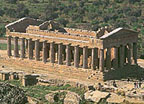 "Located on a plateau overlooking Sicily's southern coast, Agrigento was founded as Akragas around 582 BC by a group of colonists from Gela, who themselves were the immediate descendants of Greeks from Rhodes and Crete. Akragas was renamed Agrigentum by the Romans, and Girgenti by the Saracens, only to be christened Agrigento in 1927, but the place is the same.
"Located on a plateau overlooking Sicily's southern coast, Agrigento was founded as Akragas around 582 BC by a group of colonists from Gela, who themselves were the immediate descendants of Greeks from Rhodes and Crete. Akragas was renamed Agrigentum by the Romans, and Girgenti by the Saracens, only to be christened Agrigento in 1927, but the place is the same.
Akragas, named for the nearby river, flourished under Phalaris (570-554 BC), and developed further under Theron (488-471 BC), whose troops participated in the Battle of Himera in 480 BC, defeating the Carthaginians. Agrigento was destroyed several times during the Punic Wars, suffering particularly extensive damage during a siege by Roman forces in 261 BC, but always rebuilt. The Greek poet Pindar (518-438 BC) described Akragas as "the most beautiful city of the mortals." Akragas' most famous citizen was the philosopher and scientist Empedocles (490-430 BC)."
Roman Legionary's Exam Certificate Unearthed in Norfolk
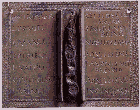 "Archaeologists have uncovered the earliest examination certificate ever found in Britain. Fragments of two bronze sheets, which had been threaded together, were unearthed by metal detector enthusiasts in Norfolk.
"Archaeologists have uncovered the earliest examination certificate ever found in Britain. Fragments of two bronze sheets, which had been threaded together, were unearthed by metal detector enthusiasts in Norfolk.
The diploma was awarded in AD98 to a garrison soldier whose name has not survived but who was recruited in the imperial province of Pannonia, now the Balkans. Lettering inscribed on the eroded metal shows that he served in the legions from AD73, most of the time in Britain.
His certificate acknowledges lessons learned during 25 years in the Roman army, lessons which became as subject to controversy and allegations of cheating as any modern exam. "
Did Boudicca's Army Desecrate the Graves of the Vanquished in Londonium?
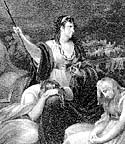 "Archaeologists from Wessex Archaeology found a small cremation cemetery from London's earliest years that had been severely disturbed some time before the 70s - the date is given by a coin overlying the site.
"Archaeologists from Wessex Archaeology found a small cremation cemetery from London's earliest years that had been severely disturbed some time before the 70s - the date is given by a coin overlying the site.
Contemporary with the cremation cemetery, the partly-decomposed body of a middle-aged or elderly man had been thrown into an open drainage ditch, with the partly-decayed head of a young woman placed between his legs. The bodies were left uncovered. The man's skeleton was missing its lower legs, while the woman's skull had lost its jawbone.
Although mutilated and other 'strange' burials are not unknown in Roman Britain (British Archaeology, March), these remains do seem to represent body-parts that had been roughly removed from their original graves, perhaps quite soon after burial, in an act of deliberate desecration. 'It is hard not to associate this with Boudicca's sack of London, as the dates match,' said project director Chris Moore."
Monday, August 25, 2003
Despised Tomb May Be Burial Chamber of Biblical Prophets
 "For centuries passers-by have thrown rocks at an ornate tomb in Jerusalem's Kidron Valley, reviled as the traditional burial place of the biblical King David's villainous son Absalom.
"For centuries passers-by have thrown rocks at an ornate tomb in Jerusalem's Kidron Valley, reviled as the traditional burial place of the biblical King David's villainous son Absalom.
But in one of those strange twists unique to the Holy Land -- where tombs can post-date by a millennium those believed buried there -- an inscription found on the crypt now points to it belonging not to Absalom but rather John the Baptist's father, Zacharias, and maybe even James, who some Christians regard as the brother of Jesus."
Friday, August 22, 2003
Hadrian and wife statues unearthed at Sagalassos
A team of Belgian archaeologists from Leuven University uncovered a second-century fountain and five-metre statues of the Emperor Hadrian and his wife Sabina.
Director Marc Waelkens explains, "We are now exposing the monumental city center and have completed, or nearly completed, four major restoration projects there. We've also undertaken an intensive urban and geophysical survey, excavations in the domestic and industrial areas, and an intensive survey of its vast territory. Whereas the former document a thousand years of occupation, from Alexander the Great to the seventh century, the latter has established the changing settlement patterns, the vegetation history and farming practices, the landscape formation and climatic changes during the last 10,000 years."
Director Marc Waelkens explains, "We are now exposing the monumental city center and have completed, or nearly completed, four major restoration projects there. We've also undertaken an intensive urban and geophysical survey, excavations in the domestic and industrial areas, and an intensive survey of its vast territory. Whereas the former document a thousand years of occupation, from Alexander the Great to the seventh century, the latter has established the changing settlement patterns, the vegetation history and farming practices, the landscape formation and climatic changes during the last 10,000 years."
Monday, August 18, 2003
2nd Century Etruscan Family Tomb in Perugia Dazzles Visitors
 "Discovered entirely by accident in 1840 during road construction, the hypogeum in Perugia (2nd century BC), is the biggest of the 38 graves found in the surrounding Palazzone burial ground.
"Discovered entirely by accident in 1840 during road construction, the hypogeum in Perugia (2nd century BC), is the biggest of the 38 graves found in the surrounding Palazzone burial ground.
"A steep flight of stairs leeds to the travertine doorway, still intact, which bears a vertical three line inscription related to the construction of the tomb, owned by the Etruscan Velimna family. The layout of the rooms around the atrium is the same as in Etruscan and Roman houses, with the difference that what appear to be wooden beams supporting the roof are in fact the ceiling that has been carved out of sheer rock."
"...The urn containing the remains of the head of the family, Arnth Velimna, stands at the centre on a base. The base is decorated with two winged female demons, or “vanth”, that were precursors of genii in the Roman pantheon and have similarities with what came to be known as angels for Christians. They guard the painted entrance to the Empire of Death."
Thursday, August 14, 2003
Roman port from Hannibalic War revealed in Pozzuoli
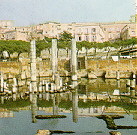 "Excavators at Pompeii, entombed in ash and toxic debris by the eruption of Mount Vesuvius in AD 79, were able to remove the volcanic material and expose the city to the open air.
"Excavators at Pompeii, entombed in ash and toxic debris by the eruption of Mount Vesuvius in AD 79, were able to remove the volcanic material and expose the city to the open air.
But in Pozzuoli, whose beauty was such that the great Roman orator Cicero called it 'little Rome,' the ancient streets were encased in the foundations of a new city built by the Spanish in the 1500s, when they ruled what was then the Kingdom of Naples."
After 10 years of excavation, the Roman city originally constructed as a seaport during the Hannibalic War (Second Punic War) has emerged.
Visitors may see "well-preserved warren of Roman streets, paved with huge stones and lined with little shops, inns and houses."
"Small private altars are visible in the corners of some of the shops and there are also ancient flour mills, deep wells, vaulted storage rooms and stone heads that used to be fountains."
"A vast, white marble temple from the first century BC stands there, with well-preserved colonnades and walls. It also features gilded arches, a white and gold dome and fragments of religious frescoes -- the remains of a Baroque church which the Spanish built using the ancient structure."
Friday, August 08, 2003
Efforts Mount to Save 1st century Venus statue
 "The British Government has placed a temporary export ban on a Roman statue of Venus in the hope that it can be bought for the nation. The marble statue, described as being of "outstanding significance", has been dated to circa late 1st/mid-2nd Century AD and is a Roman copy of a Hellenistic original of 2nd Century BC. Known as Jenkins Venus, the statue, originally bought in Rome in 1765 , was resold at auction earlier in the year by an anonymous foreign buyer for a record £7.9m to pay for the refurbushiment of Newby Hall in North Yorkshire .
"The British Government has placed a temporary export ban on a Roman statue of Venus in the hope that it can be bought for the nation. The marble statue, described as being of "outstanding significance", has been dated to circa late 1st/mid-2nd Century AD and is a Roman copy of a Hellenistic original of 2nd Century BC. Known as Jenkins Venus, the statue, originally bought in Rome in 1765 , was resold at auction earlier in the year by an anonymous foreign buyer for a record £7.9m to pay for the refurbushiment of Newby Hall in North Yorkshire .
Ancient Women Used Dung, Grease as Makeup
 "For the ancient Romans, looking good didn't stop at applying makeup. Archaeologists have found tools such as tweezers for trimming the brows and small scoops for cleaning out the ears. The devices were likely used by both men and women, says Rosenberg."
"For the ancient Romans, looking good didn't stop at applying makeup. Archaeologists have found tools such as tweezers for trimming the brows and small scoops for cleaning out the ears. The devices were likely used by both men and women, says Rosenberg."
As the ancient Roman writer, Plotinus, declared in A.D. 250, "This is the spirit that Beauty must ever induce: a wonderment and a delicious trouble, longing and love and a trembling that is all delight."
Ancient writings and recovered artifacts have revealed women could be quite creative when finding ways to touch up their looks. One secret, for example, was extracting the sweat and dirt from sheep's wool to form the basis of a paling face cream.
Sally Pointer, an archaeologist and specialist in cosmetics history, says A pale face suggested an upper-class life of leisure spent away from the sun's harsh rays. Some women patted dried crocodile dung on their faces. Others used chalk and the ground root of the orris, a type of iris, which can be poisonous.
Caligula's Roman palace discovered
 "The ancient palace in Rome that provided the backdrop for many of Emperor Caligula's wildest depravities has been found by British and American archaeologists. It has been located at the foot of the Palatine Hill, at a point where it met and joined the Temple of Castor and Pollux.
"The ancient palace in Rome that provided the backdrop for many of Emperor Caligula's wildest depravities has been found by British and American archaeologists. It has been located at the foot of the Palatine Hill, at a point where it met and joined the Temple of Castor and Pollux.
The discovery confirmed the belief that Caligula - who had himself deified - had the audacity to incorporate the sacred temple into his home. Andrew Wallace-Hadrill, head of the British School, said: "The ancient sources claim that Caligula transformed the Temple of Castor and Pollux into the vestibule of his palace. The new excavations greatly strengthen the case for supposing that Caligula's building actually came up to the temple.
Wednesday, July 30, 2003
Tellaro Mosaic Contradicts Homer's Iiad
Dazzling Roman mosaics discovered near the site of the ancient city of Eloro on Sicily apparently contradict Homer's account of the Trojan war in his epic poem, the Iliad.
"One mosaic depicts the story of the recovery of Hector's body from Achilles, who after killing King Priam's eldest son, dragged his corpse around the walls of Troy, tied to his chariot. Amid a group of Greek and Trojan figures including Achilles and Diomedes, and old King Priam of Troy, Hector's body is shown lying on one of the two plates of a weighing scales, while on the other is Priam's treasure. The scene implies that the ransom for Hector's body was calculated according to his physical weight, rather than his honour, the traditional ancient yardstick for such matters."
"One mosaic depicts the story of the recovery of Hector's body from Achilles, who after killing King Priam's eldest son, dragged his corpse around the walls of Troy, tied to his chariot. Amid a group of Greek and Trojan figures including Achilles and Diomedes, and old King Priam of Troy, Hector's body is shown lying on one of the two plates of a weighing scales, while on the other is Priam's treasure. The scene implies that the ransom for Hector's body was calculated according to his physical weight, rather than his honour, the traditional ancient yardstick for such matters."
Monday, July 28, 2003
Etched Gladiator on glass fragment most exciting find of 2003 at Whitehall Farm Roman Villa & Landscape Project
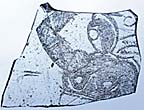 A small piece of fine glass, engraved or etched with the figure of a gladiator is one of the most exciting finds this year at the Whitehall Farm Roman Villa and Landscaping Project. Part of a drinking vessel, it was found in the sealed context of room 3B of the bath house.
A small piece of fine glass, engraved or etched with the figure of a gladiator is one of the most exciting finds this year at the Whitehall Farm Roman Villa and Landscaping Project. Part of a drinking vessel, it was found in the sealed context of room 3B of the bath house.
Researchers said this is only the fifth gladiator vessel found so far in the UK.
Other finds this season include a square game piece, a bone hairpin, and a silver denarius minted by the house of Severus.
3rd Century BC Industrial Iron Ore Kilns Discovered in Lecco, Italy
"According to Marco Tizzoni of Bergamo University 'it is the most ancient proof of iron ore reduction in the [Lombardy] region found thus far. We are looking at what are probably some of the first proto-historic mines in Lombardy'.
The kilns were very simple: small clay structures resting at the feet of the mountain, they were used in conjunction with hand driven vents, which allowed for the creation of iron in a paste form'. "
The kilns were very simple: small clay structures resting at the feet of the mountain, they were used in conjunction with hand driven vents, which allowed for the creation of iron in a paste form'. "
Roman cosmetics' found at ancient dig
Excavators at the site of a major Roman temple in London have found a sealed box containing a white cream still bearing the fingermarks of the person who last used it, nearly 2,000 years ago. Museum conservator Liz Barham who opened the fist-sized cylindrical tin box for the first time on Monday, in front of the world's media, described the smell from the half-full container as "sulphurous" and "cheesy." The substance, which will now be chemically analyzed, could be face cream or even face paintsaid Museum of London curator Francis Grew.
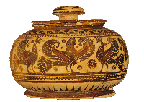 William Smith, D.C.L., LL.D., in an article in A Dictionary of Greek and Roman Antiquities of 1875 explains, "The practice of painting the face was very general among the Greek ladies, and probably came into fashion in consequence of their sedentary mode of life, which robbed their complexions of their natural freshness, and induced them to have recourse to artificial means for restoring the red and white of nature. This at the least is the reason given by some of the ancient writers themselves (Xen. Oecon. 10 c.10; Phintys, ap. Stobaeum, tit. lxxiv.61). The practice, however, was of great antiquity among the Greeks, and was probably first introduced among the Asiatic Ionians from the East, where the custom has prevailed from the earliest times. "
William Smith, D.C.L., LL.D., in an article in A Dictionary of Greek and Roman Antiquities of 1875 explains, "The practice of painting the face was very general among the Greek ladies, and probably came into fashion in consequence of their sedentary mode of life, which robbed their complexions of their natural freshness, and induced them to have recourse to artificial means for restoring the red and white of nature. This at the least is the reason given by some of the ancient writers themselves (Xen. Oecon. 10 c.10; Phintys, ap. Stobaeum, tit. lxxiv.61). The practice, however, was of great antiquity among the Greeks, and was probably first introduced among the Asiatic Ionians from the East, where the custom has prevailed from the earliest times. "
He continues, "In order to produce a fair complexion, cerussa, or white lead was employed. The eye-brows and eye-lids were stained black with a sulphuret of antimony, which is still employed by the Turkish ladies for the same purpose. The eye-brows were likewise stained with a preparation of soot.
Roman ladies even went so far as to paint with blue the veins on the temples, as we may infer from Propertius (ii.14.27) "si caeruleo quaedam sua tempore fuco tinxerit." The ridiculous use of patches (splenia), which were common among the English ladies in the reign of Queen Anne and the first Georges, was not unknown to the Roman ladies (Mart. ii.29.9, x.22; Plin. Ep. vi.2). The more effeminate of the male sex at Rome also employed paint. Cicero speaks (in Pison. 11) of the cerussatae buccae of his enemy, the consul Piso.
See also: Fucus
Cosmetics were also valuable trade items:
I also came across this reference:
"From Homer's day forward, precious oils, perfumes, cosmetic powders, eye shadows, skin glosses and paints, beauty unguents, and even hair dyes seem to have been in near universal use. Export and sale of these items formed an important part of trade around the Mediterranean. During the 8th and 7th centuries BC, overseas markets were dominated by Corinthian, Rhodian and East Greek perfume flasks and cosmetic containers, including aryballoi, alabastra, pyxides and other small specialized shapes. Cosmetic unguents were imported into Greece in containers carved from the Red Sea Tridacna shell."
 William Smith, D.C.L., LL.D., in an article in A Dictionary of Greek and Roman Antiquities of 1875 explains, "The practice of painting the face was very general among the Greek ladies, and probably came into fashion in consequence of their sedentary mode of life, which robbed their complexions of their natural freshness, and induced them to have recourse to artificial means for restoring the red and white of nature. This at the least is the reason given by some of the ancient writers themselves (Xen. Oecon. 10 c.10; Phintys, ap. Stobaeum, tit. lxxiv.61). The practice, however, was of great antiquity among the Greeks, and was probably first introduced among the Asiatic Ionians from the East, where the custom has prevailed from the earliest times. "
William Smith, D.C.L., LL.D., in an article in A Dictionary of Greek and Roman Antiquities of 1875 explains, "The practice of painting the face was very general among the Greek ladies, and probably came into fashion in consequence of their sedentary mode of life, which robbed their complexions of their natural freshness, and induced them to have recourse to artificial means for restoring the red and white of nature. This at the least is the reason given by some of the ancient writers themselves (Xen. Oecon. 10 c.10; Phintys, ap. Stobaeum, tit. lxxiv.61). The practice, however, was of great antiquity among the Greeks, and was probably first introduced among the Asiatic Ionians from the East, where the custom has prevailed from the earliest times. "
He continues, "In order to produce a fair complexion, cerussa, or white lead was employed. The eye-brows and eye-lids were stained black with a sulphuret of antimony, which is still employed by the Turkish ladies for the same purpose. The eye-brows were likewise stained with a preparation of soot.
Roman ladies even went so far as to paint with blue the veins on the temples, as we may infer from Propertius (ii.14.27) "si caeruleo quaedam sua tempore fuco tinxerit." The ridiculous use of patches (splenia), which were common among the English ladies in the reign of Queen Anne and the first Georges, was not unknown to the Roman ladies (Mart. ii.29.9, x.22; Plin. Ep. vi.2). The more effeminate of the male sex at Rome also employed paint. Cicero speaks (in Pison. 11) of the cerussatae buccae of his enemy, the consul Piso.
See also: Fucus
Cosmetics were also valuable trade items:
I also came across this reference:
"From Homer's day forward, precious oils, perfumes, cosmetic powders, eye shadows, skin glosses and paints, beauty unguents, and even hair dyes seem to have been in near universal use. Export and sale of these items formed an important part of trade around the Mediterranean. During the 8th and 7th centuries BC, overseas markets were dominated by Corinthian, Rhodian and East Greek perfume flasks and cosmetic containers, including aryballoi, alabastra, pyxides and other small specialized shapes. Cosmetic unguents were imported into Greece in containers carved from the Red Sea Tridacna shell."
Friday, July 18, 2003
Conservation Continues at Sagalassos
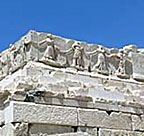 A beautiful frieze of dancing girls that adorns the NW Heroon, an honorific monument, dedicated to a prominent figure of the city and built in Augustan times (25 B.C.-A.D. 14), has been freed of its winter protection. A new study of the naiskos (platform) blocks indicated that almost nothing was missing of the latter. Also, it turned out that it was not a distylos in antis (two columns set between projecting side walls), but a tetrastyle prostylos (four columns set in front of the cella) shrine built in the Corinthian order.
A beautiful frieze of dancing girls that adorns the NW Heroon, an honorific monument, dedicated to a prominent figure of the city and built in Augustan times (25 B.C.-A.D. 14), has been freed of its winter protection. A new study of the naiskos (platform) blocks indicated that almost nothing was missing of the latter. Also, it turned out that it was not a distylos in antis (two columns set between projecting side walls), but a tetrastyle prostylos (four columns set in front of the cella) shrine built in the Corinthian order.
Work also continues on the Antonine Nymphaeum, a monumental fountain located on the north side of the Upper Agora and dated to the reign of Marcus Aurelius (A.D. 161-180).
Wednesday, July 16, 2003
Roman brooch discovery pushes ancient frontiers farther north in Scotland
 A Roman brooch, dated to between 50BC and 50AD, has been discovered by amateur archaeologists in Shetland. The ancient pin could have belonged to an islander returning to the area around Norwick on Shetland after serving in the Roman army.
A Roman brooch, dated to between 50BC and 50AD, has been discovered by amateur archaeologists in Shetland. The ancient pin could have belonged to an islander returning to the area around Norwick on Shetland after serving in the Roman army.
Experts at the British Museum believe the one found on Shetland, from the late Iron age/early Roman period, could have been made in Germany.
Dr Alan Leslie, director of the Glasgow University archaeological research division, said: "The brooch gives an indication of the extensive trading networks at the time.
"It could have been used as something to barter with and is certainly a very special find. There was substantial seaborne mercantile activity but it could have got there via other agencies. The Roman army was established in different areas and shifted about a lot. There were legionaries who were Roman citizens and auxiliary units from allied or conquered countries. Someone could join the army, serve their 25 years, and then move back to their locality."
Weekend detectors find variety of ancient brooches
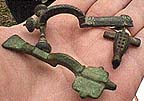 Digs sponsored by The Weekend Wanderers Detecting Club, founded by Peter Welch in 1997, have yielded an impressive variety of early Roman and Saxon brooches. Weekly digs take place in and around Hertfordshire, Buckinghamshire, Berkshire, Hampshire, Surrey, and Oxfordshire in the UK.
Digs sponsored by The Weekend Wanderers Detecting Club, founded by Peter Welch in 1997, have yielded an impressive variety of early Roman and Saxon brooches. Weekly digs take place in and around Hertfordshire, Buckinghamshire, Berkshire, Hampshire, Surrey, and Oxfordshire in the UK.
Fish fossils reveal Roman trade routes: Genetics shows ancient Anatolians imported Egyptian catfish
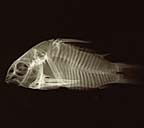 Fish fossils found in an excavation of Sagalassos, 110 kilometres inland from Turkey's southern Mediterranean coast, have added to growing evidence that Sagalassos had connections with far-flung regions of the Roman Empire. 1400-year old remains of an Egyptian catfish dinner were identified by genetic analysis.
Fish fossils found in an excavation of Sagalassos, 110 kilometres inland from Turkey's southern Mediterranean coast, have added to growing evidence that Sagalassos had connections with far-flung regions of the Roman Empire. 1400-year old remains of an Egyptian catfish dinner were identified by genetic analysis.
"The catfish was probably a delicacy for aristocrats," says the director of the dig Marc Waelkens from the Catholic University of Leuven, Belgium. Romans may also have imported these and other exotic fish to stock their decorative pools. Waelkens and his colleagues found Nile perch (Lates niloticus) and African tilapia (Tilapia zillii) at the site too, they report in this month's Journal of Archaeological Science .
Ancient Roman Fonts
 Michael Scarpitti has designed some unique fonts "based on historical sources from different eras of the Roman Empire and are extraordinarily accurate to the details of the different lettering styles which they represent. These are not modernized abstractions of popular styles like Rustica and Roman Uncial, but grittier, more interesting designs derived directly from ancient manuscripts and inscriptions. This is Roman lettering as it was actually done, not a contemporary designer's reinterpretation."
Michael Scarpitti has designed some unique fonts "based on historical sources from different eras of the Roman Empire and are extraordinarily accurate to the details of the different lettering styles which they represent. These are not modernized abstractions of popular styles like Rustica and Roman Uncial, but grittier, more interesting designs derived directly from ancient manuscripts and inscriptions. This is Roman lettering as it was actually done, not a contemporary designer's reinterpretation."
His entire set of fonts is available for $49 and he provides Falconis as a free download.
Thursday, July 10, 2003
New Research Reveals Petillius Cerialis Rather Than Agricola founder of Roman Scotland
The traditional view, that the Roman frontier in Scotland was established in the 80s through the campaigns of the governor Agricola has been overturned by findings at the Roman Gask project excavations at Coldoch. The theory was based largely on the writings of Tacitus, Agricola's son-in-law. According to Birgitta Hoffmann, deputy director of the project, the new evidence suggests the founder was more likely Petillius Cerialis, general and diplomat, and governor in 71-73/4.
Pollen evidence from settlements in the area shows no agricultural decline from the 70s - as would be expected if occupation had been achieved through conquest, as many native farmers would have been killed. Instead, it shows the intensification of grazing, with pastures supporting bigger herds.
Evidence from the latest season's work at Coldoch, two miles from the Roman fort of Doune, suggests the natives may have started to grow wheat - a crop not generally grown in Iron Age Scotland - to trade to the Roman army and its camp followers, who may have numbered as many as 20,000. Fragments of 1st century Roman glass at the settlement proves there was contact between incomers and natives.
Pollen evidence from settlements in the area shows no agricultural decline from the 70s - as would be expected if occupation had been achieved through conquest, as many native farmers would have been killed. Instead, it shows the intensification of grazing, with pastures supporting bigger herds.
Evidence from the latest season's work at Coldoch, two miles from the Roman fort of Doune, suggests the natives may have started to grow wheat - a crop not generally grown in Iron Age Scotland - to trade to the Roman army and its camp followers, who may have numbered as many as 20,000. Fragments of 1st century Roman glass at the settlement proves there was contact between incomers and natives.
Ancient canats (water canals) restored for use in Syria
A village, located approximately 70 kilometers southeast of Aleppo near the town of Khanasser, is the first in Syria to have its qanats (water canals), which date from Byzantine times, reactivated. This program, in partnership with the International Center for Research in Dry Areas (ICARDA) and the directorate of the National Museum of Aleppo, gives the locals of Shalala Saghira the chance to use this ancient yet clean and efficient way of getting their water.
During Roman times, these canals connected cities such as Duro Europos, Bosra and Palmyra. The paths of the qanats (basically large tunnels) are so big that one could drive a car through them. The Romans were probably the biggest builders of qanats, though other civilizations also contributed their irrigation techniques to the region. Qanats rely on gravity to carry water and are considered environmentally sound because they do not deplete groundwater resources.
There are an estimated 2,000 qanats in Syria, of which 91 have been identified at 41 sites in the country, with another 30 still flowing.
During Roman times, these canals connected cities such as Duro Europos, Bosra and Palmyra. The paths of the qanats (basically large tunnels) are so big that one could drive a car through them. The Romans were probably the biggest builders of qanats, though other civilizations also contributed their irrigation techniques to the region. Qanats rely on gravity to carry water and are considered environmentally sound because they do not deplete groundwater resources.
There are an estimated 2,000 qanats in Syria, of which 91 have been identified at 41 sites in the country, with another 30 still flowing.
Wednesday, June 25, 2003
Was Constantine's Miracle a Meteor?
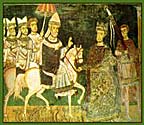 In the fourth century AD, the fragmented Roman Empire was being further torn apart by civil war. Constantine and Maxentius were bitterly fighting to be the sole emperor.
In the fourth century AD, the fragmented Roman Empire was being further torn apart by civil war. Constantine and Maxentius were bitterly fighting to be the sole emperor.
Constantine was the son of the western emperor Constantius Chlorus. When he died in 306, his father's troops proclaimed Constantine emperor. But in Rome, the favourite was Maxentius, son of Constantius' predecessor, Maximian.
Constantine overran Italy and faced Maxentius at the Milvian Bridge over the Tiber a few kilometres from Rome. Both knew it would be a decisive battle with Constantine's forces outnumbered.
But something strange happened. Eusebius, an early Christian historian, reports, "...about noon, when the day was already beginning to decline, he saw with his own eyes the trophy of a cross of light in the heavens, above the Sun, and bearing the inscription 'conquer by this'. "
Jens Ormo, a Swedish geologist, and colleagues working in Italy believe Constantine witnessed a meteoroid impact. The research team believes it has identified what remains of the impactor's crater. Radiocarbon dating puts the crater's formation at about the right time to have been witnessed by Constantine
Sunday, June 22, 2003
Edinburgh engineer proves Colosseum could have been flooded
 Academics have long argued that holding sea battles at the Colosseum was impossible . But, Cassius Dio, chronicler of ancient Rome, said: "Titus suddenly filled this same theatre with water and brought in horses and bulls and other domesticated animals that had been taught to behave in the liquid element just as on land. He also brought in people on ships, who engaged in a sea-fight there, impersonating the Corcyreans and Corinthians."
Academics have long argued that holding sea battles at the Colosseum was impossible . But, Cassius Dio, chronicler of ancient Rome, said: "Titus suddenly filled this same theatre with water and brought in horses and bulls and other domesticated animals that had been taught to behave in the liquid element just as on land. He also brought in people on ships, who engaged in a sea-fight there, impersonating the Corcyreans and Corinthians."
Now, Martin Crapper, lecturer in civil and environmental engineering at Edinburgh University was able to prove it was possible for sluice gates to be closed off and for water pressure to reach the correct level for the arena to be flooded by four million gallons of water to a depth of five feet within seven hours.
Saturday, June 14, 2003
Roman barge raised from the bottom of the Rhine River
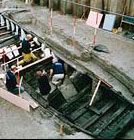 Although silted over centuries ago, a Roman barge that has stayed waterlogged for nearly 2,000 years, preserving the vessel and its contents, has been raised from the bottom of the Rhine River near the city of Utrecht. It is 25 metres long and 2.7 m wide, and is the first to be found with a cabin containing an entire inventory of items that have been fully preserved--from the captains kitchen, bed and chest, down to the contents of his cupboard.
Although silted over centuries ago, a Roman barge that has stayed waterlogged for nearly 2,000 years, preserving the vessel and its contents, has been raised from the bottom of the Rhine River near the city of Utrecht. It is 25 metres long and 2.7 m wide, and is the first to be found with a cabin containing an entire inventory of items that have been fully preserved--from the captains kitchen, bed and chest, down to the contents of his cupboard.
"Weve found indications of military soldiers on board, from the spiked shoes that they normally used, to lance points and axes: standard equipment of the Roman soldier," said Andre Van Holk, the maritime archaeologist heading the research team. The archaeologists believe that this barge will provide insights into how the Romans organised their defence systems.
Cathedral of Roman Emperor Otto the Great Rediscovered in East Germany
 A giant cathedral in eastern Germany known to have been built by Holy Roman Emperor Otto the Great in the 10th Century has been unearthed in Magdeburg. Laden with Italian marble, glass mosaic stones and glazed wall tiles--remains of which were all found at the site--the romanesque cathedral was as extraordinary in its beauty as in its size.
A giant cathedral in eastern Germany known to have been built by Holy Roman Emperor Otto the Great in the 10th Century has been unearthed in Magdeburg. Laden with Italian marble, glass mosaic stones and glazed wall tiles--remains of which were all found at the site--the romanesque cathedral was as extraordinary in its beauty as in its size.
"It was the largest house of worship north of the Alps apart from the Cologne Cathedral," said Kuhn, adding that it was believed to have measured 80 metres long and 60 metres high. It was Otto the Greats final resting place, but was destroyed by fire in 1207.
See also: http://www.newadvent.org/cathen/11354a.htm
Subscribe to:
Comments (Atom)